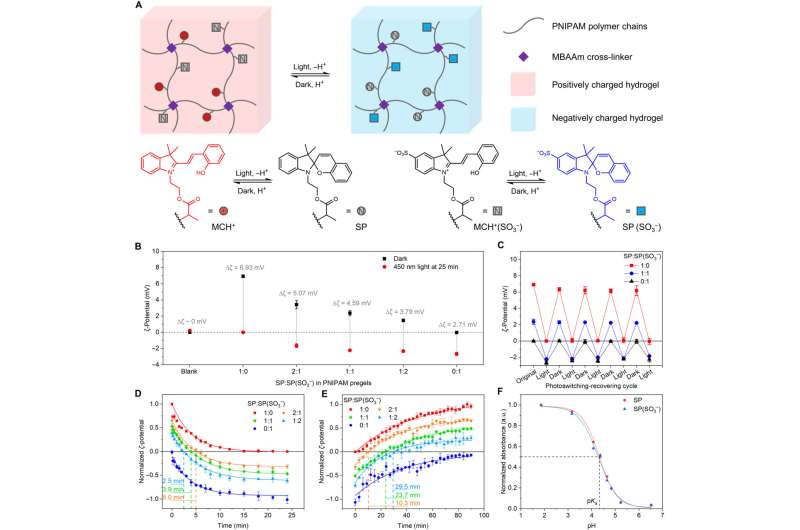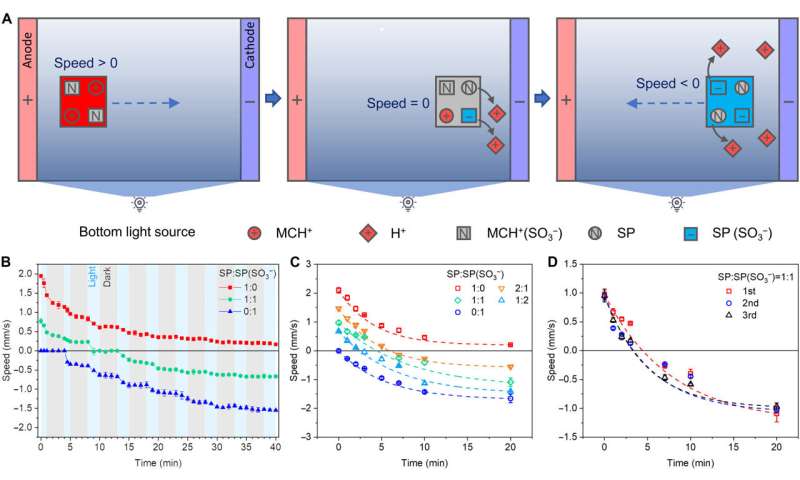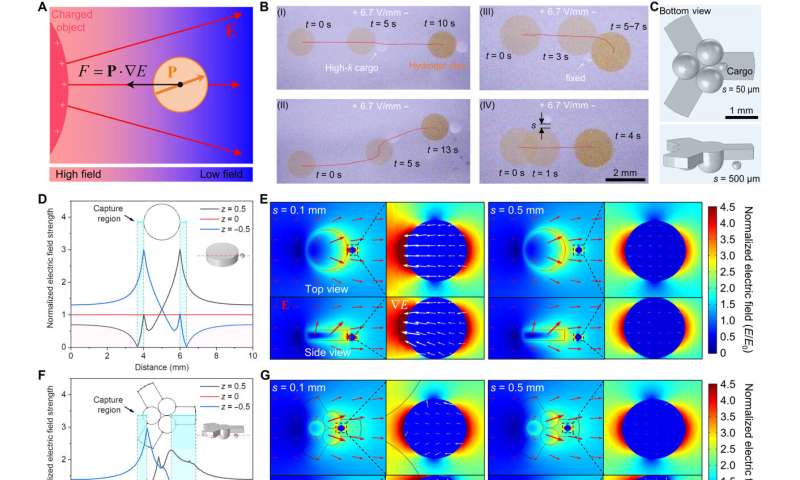August 22, 2023 feature
This article has been reviewed according to Science X's editorial process and policies. Editors have highlighted the following attributes while ensuring the content's credibility:
fact-checked
peer-reviewed publication
trusted source
proofread
Hydrogel locomotion regulated by light and electric fields

Materials scientists aim to develop autonomous materials that function beyond stimulus responsive actuation. In a new report in Science Advances, Yang Yang and a research team in the Center for Bioinspired Energy Science at the Northwestern University, U.S., developed photo- and electro-activated hydrogels to capture and deliver cargo and avoid obstacles on return.
To accomplish this, they used two spiropyran monomers (photoswitchable materials) in the hydrogel for photoregulated charge reversal and autonomous behaviors under a constant electric field. The photo/electro-active materials could autonomously perform tasks based on constant external stimuli to develop intelligent materials at the molecular scale.
Bioengineering a charged hydrogel
Soft materials with life-like functionality have promising applications as intelligent, robotic materials in complex dynamic environments with significance in human-machine interfaces and biomedical devices. Yang and colleagues designed a photo- and electro-activated hydrogel to capture and deliver cargo, avoid obstacles, and return to its point of departure, based on constant stimuli of visible light and applied electricity. These constant conditions provided energy to guide the hydrogel.
The research team covalently integrated spiropyran moieties with varying substituents into the constructs to regulate the net charge of the soft materials. They used finite element simulations to guide the design and movement of the charged hydrogels and engineer 3D surface profiles to maximize the dielectrophoretic effect. Yang and the team further studied the scope of electroactive locomotion and photoactuation in the spiropyran hydrogels.
Charge reversal of spiropyran-functionalized polymers
Yang and colleagues used two different spiropyran molecules with different net charges. They synthesized each of the molecules with a polymerizable methacrylate group based on existing reports.
They incorporated different ratios of the spiropyran molecules into N-isopropylacrylamide polymer chains (PNIPAM) to form hydrogels. In this instance, they tuned the charge reversal functionalities using copolymers of the spiropyran structural units to show photoswitchable potential and charge reversible behaviors with tunable charge. The scientists tuned the charge reversal time by changing the ratio of the two spiropyran moieties, without changing the switching and recovery rates.
Photo-activated electroactive motion of the spiropyran-PNIPAM hydrogels
Based on charge reversal behavior of the polymers, Yang's team photoregulated the electroactive hydrogels by using a crosslinker to prepare them.
At first, the team could positively charge the hydrogel to move towards the cathode under a direct current electric field, where the positive charge transferred from the spiropyran moieties into the hydrogel network. Thereafter, the permanently bound sulfonate groups on the polymer chain made the net charge of the construct negative, allowing the negatively charged hydrogel to navigate back to the anode.
The team studied the photoregulated electroactive locomotion speeds of the hydrogel disks across multiple light-dark cycles to examine their locomotion speed, and determined the relationship between the charge and speed of the hydrogel disks. They based this on the balance between the electrostatic force and hydrodynamic drag force, where the higher applied voltage and larger diameter of the hydrogel disks delivered higher locomotion speed. Such polymeric devices are well-suited to capture and deliver cargo through autonomous hunting.
Capturing and delivering cargo
Yang and colleagues explored the cargo delivery potential of the constructs by engineering simple disk-shaped spiropyran-PNIPAM hydrogels and sphere-shaped constructs embedded with nanoparticles as cargos. The strong dielectrophoretic force allowed the materials to undergo autonomous hunting and picking up functions.
Based on simulations, Yang and colleagues formed a 3-arm spiropyran PNIPAM hydrogel object using photoinitiated free radical polymerization with superior capture capability of the cantilever arms. When uncharged, the electric field gradient around the hydrogel vanished, enabling autonomous cargo release during charge reversal. The cargo release also occurred by turning off the electric field.
-

Photoregulated electroactive locomotion of the spiropyran-PNIPAM hydrogels. (A) Schematic illustration of the photoregulated electroactive locomotion of SP/SP(SO3−) spiropyran-PNIPAM hydrogels with the ability to swim toward the cathode that navigate back to the anode autonomously under constant stimuli of electric field and light irradiation. The dashed arrows indicate the locomotion direction of the hydrogel; the curved arrows indicate the charge exchange between the hydrogel and the solution. (B) Electroactive locomotion speed of the spiropyran hydrogel discs during serial cycles of light (blue, 1 to 2 min) and dark (gray, 3 min) periods. (C) Locomotion speed of spiropyran hydrogel discs versus time of light irradiation (0.95 mW/cm2) for different SP/SP(SO3−) molar ratios after overnight incubation in 5 mM HCl. (D) Repeated locomotion speed measurements of spiropyran hydrogel discs with the SP/SP(SO3−) molar ratio of 1:1. Each measurement was performed after a two-hour period of darkness of the hydrogel in 5 mM HCl. The reference curves are fitted with an exponential function. Error bars represent the SD of the data collected from 0.3-s locomotion trajectory during a uniform motion period with a 0.1-s interval. Credit: Science Advances, doi: 10.1126/sciadv.adi4566 -

Capture and delivery of high-k cargo using DEP forces. (A) Schematic illustration showing a high-k particle subjected to a DEP force toward the regions with higher field magnitudes under a nonuniform electric field induced by a charged object. (B) Capture and delivery of high-k cargo by the disc-shaped spiropyran-PNIPAM hydrogel with the SP/SP(SO3−) molar ratio of 1:1 including (I) rectilinear delivery, (II) hunting and picking up, (III) stop by a fixed cargo, and (IV) failed capture of the cargo at a far distance s. (C) Schematics of three-arm robot-like hydrogel. (D) Finite element calculation of normalized electric field strength along the reference line through the center of the disc-shaped hydrogel with the normalized ζ-potential z = −0.5, 0, and 0.5. The capture regions are highlighted in light blue, and the repulsive DEP region is highlighted in light red. (E) The normalized electric field strength map, field vector E (red arrows), and field gradient ∇E (white arrows) felt by the high-k particle at the distance s = 0.1 mm (left) and 0.5 mm (right) for the disc-shaped hydrogel. (F) Finite element calculation of normalized electric field strength along the reference line through the center of the three-arm hydrogel object with z = −0.5, 0, and 0.5. (G) The normalized electric field strength map, field vector E (red arrows), and field gradient ∇E (white arrows) felt by the high-k particle at the distance s = 0.1 mm (left) and 0.5 mm (right) for the three-arm hydrogel. (H and I) Calculated DEP force caused by the high-k particle versus the distance s and the normalized ζ-potential z. (J) Autonomous capture of a high-k cargo in either position (I) P1 or (II) P2 of a 1:1 SP/SP(SO3−) robot and (III) delivery of cargo when the hydrogel object returns after 7 min of irradiation. Credit: Science Advances, doi: 10.1126/sciadv.adi4566
Automatically avoiding obstacles
The research team showed how materials with a high dielectric constant induced an attractive electrophoretic force, and materials with a lower dielectric constant exerted a repulsive electrophoretic force on the adjacent charged hydrogel object.
Using finite element calculations, they showed the possibility of low dielectric constants to guide the charged hydrogel through obstacles. Under constant stimuli of the electric field and light irradiation, the hydrogel automatically bypassed barriers and traveled back after charge reversal, without human intervention.
Outlook
In this way, Yang and colleagues designed a photo- and electroactive hydrogel that can cargo capture and deliver, as well as avoid obstacles under constant external stimuli. The scientists used two different ratios of spiropyran moieties in the hydrogel and facilitated the net charge in the chemically random network to be tunable under irradiation with blue light. This enabled photoregulated, electroactive motion with autonomous behavior under the direction of light and electricity.
The autonomous soft matter products elegantly captured and delivered cargo while avoiding obstacles with applications suited for scenarios to ensure the safety of monitoring a situation from afar—for instance, where human intervention is impractical. These new biomaterials with autonomous functionality can be resourcefully engineered using environmentally sensitive electrostatic interactions and photoactuation in soft materials.
More information: Yang Yang et al, Autonomous hydrogel locomotion regulated by light and electric fields, Science Advances (2023). DOI: 10.1126/sciadv.adi4566
Anne Helene Gelebart et al, Making waves in a photoactive polymer film, Nature (2017). DOI: 10.1038/nature22987
Journal information: Science Advances , Nature
© 2023 Science X Network





















